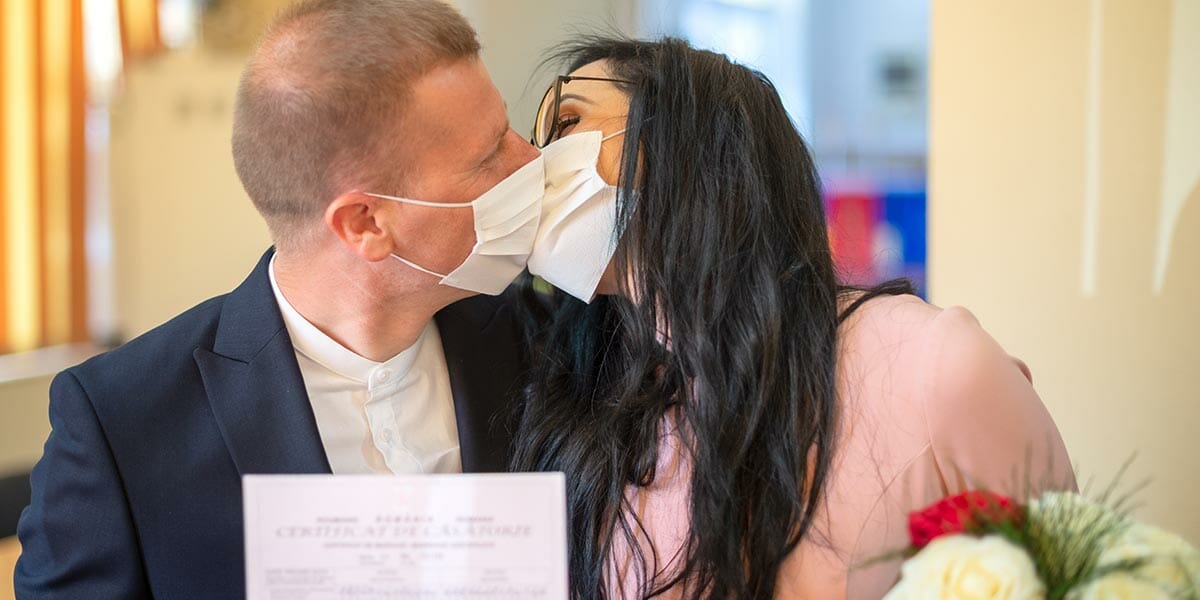
The pandemic has changed how institutions traditionally do things and marriage is no exception. Many weddings went straight to Zoom in 2020 and now, remote marriages have gone global with hundreds of international couples tying the knot virtually. Same sex couples from countries like China and the Philippines — where same-sex marriage is illegal — have also been getting married online to solidify their commitment to each other.
These types of marriages, known as proxy marriages, are a little confusing to understand, but can they work for immigration purposes? Here’s what we know.
What is a Proxy Marriage?
A proxy marriage is a marriage where one member of the couple isn’t physically present for the marriage. A stand-in takes their place where the ceremony is held. In the case of entirely virtual weddings, the officiant is in the place where the ceremony is held and each member of the couple is apart, but virtually present.
How Does Proxy Marriage Work?

Proxy marriages can be done with either one person there in-person and the other remotely, but this is dependent on local and state laws. These laws are important to check since some of them are only valid while pandemic restrictions are in place. As those restrictions are lifted, they may no longer be deemed legal marriages.
For U.S. citizens marrying each other, it’s unlikely you would ever need a proxy marriage except for certain circumstances. For instance, several states allow proxy marriages, notably Montana, for people in the military.
Proxy Marriage and Immigration

In order for a proxy marriage to be deemed legal under U.S. Citizenship and Immigration Services (USCIS), the marriage must be consummated through sexual relations. This does not include consummation prior to the marriage, so while having children together would seem to be enough and does help prove a marriage’s legitimacy, this cannot be counted as consummation if those children were born before the marriage. But, couples can and should provide evidence of the relationship prior to the marriage to help prove validity. All evidence helps.
The best way to provide proof of an authentic marriage is through an affidavit and providing proof of being together in-person after the marriage through things like written statements, photos together, plane tickets and hotel receipts. Tourist destinations can be a good place to meet during the pandemic to provide proof of getting together after the wedding.
Some of the places open to American tourists include:
- African countries: Egypt, Kenya, Morocco, South Africa and Tanzania
- Asian countries: Nepal and Thailand
- Caribbean islands: the Bahamas, Bermuda, Costa Rica, Cuba, the Dominican Republic and Jamaica
- European countries: Greece, Iceland, Ireland, Italy, Turkey and the United Kingdom
- South American countries: Brazil, Ecuador, Peru, Mexico and Nicaragua
Restrictions are subject to change based on pandemic conditions within the country itself and the countries you or your partner are coming from. It’s best to double-check before making plans to meet in-person after your nuptials.
As mentioned previously, before pursuing a proxy marriage, check local and state laws to ensure the marriage is deemed legal, especially for immigration purposes. There are still states that require marriages to be in-person in order for them to be legal.
Currently, the only state to allow entirely virtual ceremonies is Utah. The officiant must be present in the state of Utah, but you do not have to be a Utah resident to be legally married in the state. For immigrants who are entirely separated due to closed borders during the pandemic, this can be a good option before applying for a spousal visa.
If your partner is outside the United States, but is permitted to leave their country and you’d like to get married in the United States, a K-1 Visa, also known as the fiancé visa, may be the best option for you as long as you get married within the 90-day timeframe. If your partner needs to work, know that it can take time to get a work permit and find employment with this approach.
Once you’ve been married and can prove the marriage is legal and legitimate, the next step is to pursue a green card. Boundless has helped thousands of couples get their green card. Learn more about how to get started today!